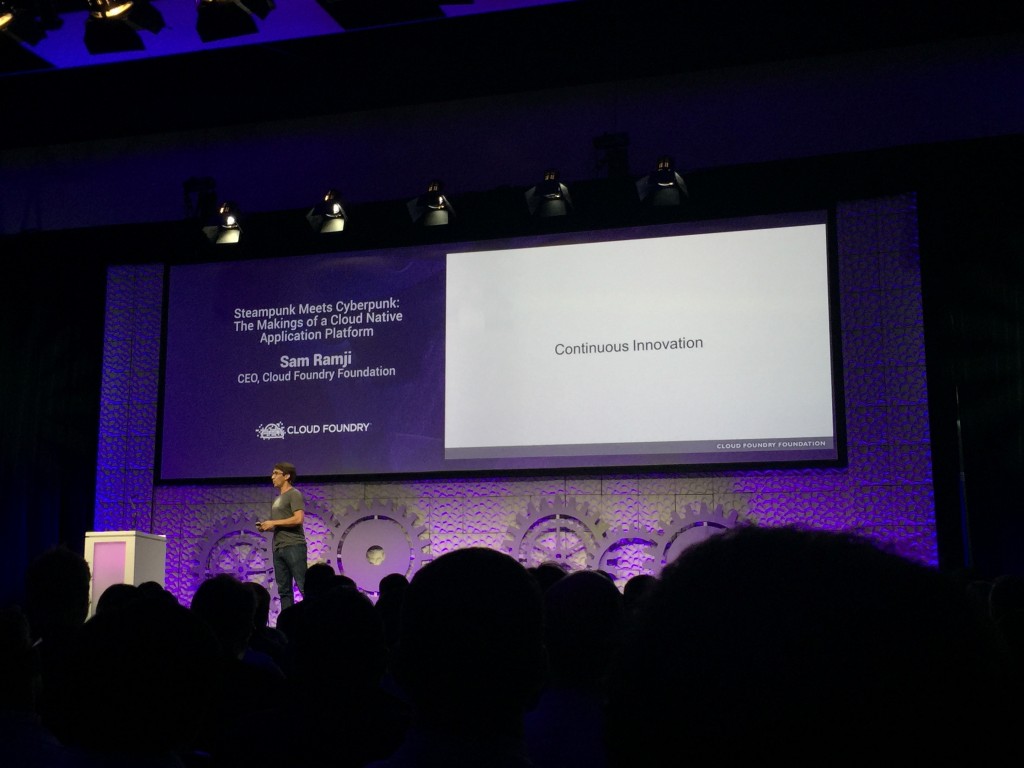The Cloud Foundry Summit 2015 (third Cloud Foundry conference in total) took place this year on May 11th and 12th at the Santa Clara Convention Center. Attending already the second time it was great to see how the community and ecosystem is growing and the products are maturing.
With more than 1500 attendees, the event was about 50% larger than last year. But more interestingly the ratio of vendors to customers changed from about 80%/20% to approximately 60%/40%, which shows the raising momentum of Cloud Foundry and PaaS in general.
The two days where packed with very interesting presentations in the key-notes and break-out sessions. It was a nice mix of vendor presentations, customer / user experience reports and technical talks on development, operations and internals of Cloud Foundry. Beside the talks there was plenty of other activities like Open House or Birds of Feather (BoF) sessions, evening events and “the Foundry”, a large exhibition, meeting and recreation area, which was ideal to get in touch with vendors and customers. For the first time there was also a diversity BoF and Lunch with more than 100 female attendees addressing the diversity gaps in the Open Source community.
All the talks have been recorded on video and made available here.

Foundation and growing Community
Exactly 110 days before the summit, the Cloud Foundry Foundation was created to be the legal entity to foster the charter of the Cloud Foundry projects. The charter is not only to execute on the goal to become the “The Best Platform for building and deploying Cloud Native applications”, but also to manage the inherent tension between project contributors that are also competitive vendors (e.g. Pivotal, IBM, HP, Swisscom, Huawei, etc.).
At the summit it became visible, that the Foundation is doing an excellent job of promoting the vision and community projects, while giving the vendors and providers room to differentiate. As the market for Platform-as-a-Service grows, interoperability and consistency will be critical factors to watch for companies looking to benefit from the application-level portability and agility that Cloud Foundry promises.
It was impressive to see how many new providers and customers joined the Cloud Foundry bandwagon during the last year. Even during the conference several announcements where made. For example, J.P. Morgan Chase joined the Cloud Foundry Foundation. Dell announced expansion of their services portfolio to include Cloud Foundry and General Electrics launches a Dojo on CloudFoundry and Internet of Things.

Bringing PaaS to the Enterprise
The inherent main topic of the conference was about bringing PaaS / Cloud Foundry and Cloud Native Applications to the Enterprise. A year ago almost only cloud providers or large corporations where operating and running PaaS installations. In this summit it came apparent that the maturity of Cloud Foundry has increased because many new smaller companies are using it.
Enterprise customers spoke in some of the sessions, including GE, Humana, Allstate, Kroger, Garmin, Comcast, and several others. Two aspects are important to these Enterprise customers:
- The technology has to be easy to install and operate. They can not afford to hire specialists to operate their installation.
- These companies talked a lot about the DevOps culture they are evolving in their IT organizations and its impact on engagement and business opportunities. This means much of the effort goes into cultural change and not technical development.
In some of the talks and discussions also some inherent shortcomings of Cloud Foundry (and PaaS in general) where discussed:
- PaaS Application Tooling
Application tooling for PaaS is still in a early stage. Either only simple applications are supported (e.g. by the CF Manifest file and the command line tool) or the functionality has to be “self” built using Continuous Deployment Tools. It would be nice to have more deployment and management tooling like BOSH but for Applications on top of Cloud Foundry, or even better multivendor PaaS capable. - Managing statefull Data
Cloud Native applications tend to be stateful by following the 12-Factor app model. But Data is by design state-full and handling of data (migration, backup, …) needs to be better integrated into Cloud Foundry. Some early research projects were discussed at the Summit. - Interoperability between Providers
To grow the next wave of Enterprise customers, they must be sure that interoperability and portability will exist between Cloud Foundry providers. A certification model will be important to determine what aspects are “core” and what are “differentiated” between implementations. - Windows and .NET Applications
Windows is still a critical platform for Enterprises. Multiple implementations of Windows and .NET compatibility have been implemented for Cloud Foundry (e.g. by Microsoft, HP, IBM and CenturyLink). These have to be unified and integrated into the Cloud Foundry core.
Cloud Foundry at ICCLab
In the ICCLab several Initiatives are addressing Cloud Foundry in our PaaS Research Theme to provide additional functionality and tooling for PaaS, like for example:
- Rating, Charging & Billing (RCB) for PaaS platform and as a Service for applications.
- Cloud Incident Management
- Cloud Orchestration
Especially we are currently working on the implementation of our Open Source Web UI for Cloud Foundry.
In addition we are also addressing the development of Application for the Cloud in our Cloud Native Application Initiative.
For further details and questions related the PaaS theme, please contact Christof Marti at ZHAW.
